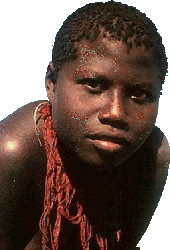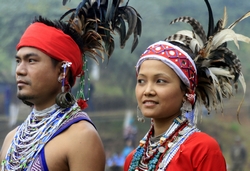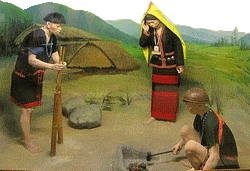°Arcus°
Home » Creation stories » The Indian subcontinent
CREATION STORIES FROM THE INDIAN SUBCONTINENT
PURUSHA - THE COSMIC MAN
IN THE VEDAS
- Purusha is the cosmic man, who is compelled to united with Prakrti (the active female principle);
- three quarters of the Purusha form the gods, whilst the other quarter forms the earth;
- Purusha, as first sacrifice, is divided up and this division gives rise to the Vedas, whilst his breath becomes Vayu. Indra and Agni emerge from his mouth, the moon from his brain and the sun from his eye;
- the Purusha's head forms the heavens, whilst his feet form the earth.
IN THE UPANISHADS
The Upanishads develop this concept further: -
- Purusha, otherwise known as Atman, becomes aware of himself. Fearfully, he looks around, before realising he is alone;
- despite the prospect of a return to fear, he desires to become two, man and woman;
- this comes to pass, and their mating produces humanity;
- but the woman, ashamed of the prospect of incest, transforms herself into a cow, whereupon the man becomes a bull. Their mating gives rise to cattle;
- the woman then transforms in turn into the female of all the animals, emulated by the man, thereby producing all life on earth.
IN THE PURANAS
In the Puranas, the process by which Purusha is identified with Atman or Brahman, the "Self" at the centre of the universe. Rather than being sacrificed, Purusha now creates via yoga, once existence comes into being via the release of the active female aspect of nature, Prakrti.
OTHER STORIES
VEDIC COSMOGONY
Aside from the Purusha model treated elsewhere, there are a number of other Vedic accounts of creation: -
- in one, the unnamed creator commits incest with his daughter. Some of his seed fell to earth (the womb of the daughter), which gives rise to the Vedas and rituals. The creator is later named as Prajapati or Brahma, whilst the daughter is Ushas;
- as a result of this incestuous affair, the creator comes to be punished by Rudra - who is, in some instances, a product of the union;
- the creator forms Agni, the fire god, from his mouth. "Fire in water" is how Vedic creation is characterised in some sources, for example Anne Birrell.
PURANIC COSMOGONY
Whilst the Puranic corpus continues to develop the philosophy of creation through the agency of Purusha, another account of creation develops from the concept of primeval waters.
In this variant, the Purusha Narayana, an avatar of Vishnu, is asleep on the surface of the primordial abyss. He awakens during the intersection of two kalpas and becomes a variety of other gods: -
- Brahma the creator;
- Vayu the wind; and
- the Cosmic Boar.
In his form of the Boar, Vishnu dives into the water to bring the earth up from the depths.
The Puranas also develop eschatological notions of the destruction of creation, via the cosmic fire emerging from the breath of Rudra (later known as Shiva), as well as winds and floods.
TANTRISM
In the beginning, only Time existed. Time was a goddess and the predominant creative power, containing the seed of all that would be.
Time proceeded to create the cosmos, growing both tired and happy. Thereafter, she brought balance to the creation.
Finally, she fashioned a female form for herself to dwell in, called Kali. From this, she made a male form, Mahakala, and the pair began to procreate.
Their union produced the first humans, to whom the couple taught the rituals of Tantrism.
BUDDHISM: THE CREATION OF THE NEXT WORLD
Buddhism posits an endless cycle of formation and destruction, and states that our world will come to an end just as those preceeding it have already ceased to exist.
However, this is not simply destructive, for the end of this cosmos causes an evolution, during which the next universe will come into being from the water and darkness between the cycles.
Eventually, after countless ages where there is no light, no humans and no other creatures, a new earth will take shape on the surface of the waters. This will prompt some materialistic entity to forsake the heavenly, intangible realm of the Buddhist soul-life for the life of the body, with the promise of the enjoyment of the sweetness of the new earth.
This pioneer will be followed by others, and they will eventually devolve into beings more flesh than Buddha soul. Their light will fade and the sun, moon and stars will emerge to compensate for this new darkening.
Some time later, humans will again evolve sexual characteristics, leading to lust and passion, which lead to selfishness and other ills.
This will only end when this cosmos, too, has run its course and dissipates into the darkness of the inert oceans of chaos.
SIKHISM
According to the Sikh religion, Sat Guru, also known as Waheguru or Ik Onkar, created the cosmos.
Sat Guru - who is neither male nor female and permeates creation - brought the cosmos into being. The cosmos evolves slowly, with air becoming water, water becoming earth and giving rise to the life on it.
ANDAMANESE

Everything was created by Pūluga, who gave his commandments to the first people. However, as time lapsed, the early humans became increasingly disobedient. In despair, Pūluga ceased to pay his errant creation visits, eventually sending a flood, resulting in the demise of all but four of the inhabitants of earth.
The survivors were two men - Loralora and Poilola - and two women - Kalola and Rimalola.
Unfortunately for them, what with the flood and all, they had lost access to fire, and discovered that all of the flora and fauna upon which they had previously relied was also gone. Pūluga duly fashioned the lush woodlands of the Andaman Islands (Marakele) to serve their needs.
BIRHOR
Singbonga created the world, having arisen from the primeval waters via the stem of a lotus, upon which he takes his seat.
From there, he sends a series of animals down into the depths to find the mud from which to fashion dry land.
Many fail, with the leech emerging victorious, spitting some mud into Singbonga's hand. From this, Singbonga makes the earth and humanity.
DHAMMAI (MIJI)

In the beginning, Shuzanghu and his wife Zumaing-Nui lived in the heights of heaven. They eventually became tired of being in air, and longed for a place to rest their feet.
Having received a promise that he would remain ever faithful, Zumaing-Nui set the process of creation in motion when, having made love with Shuzanghu, she became pregnant and bore Earth and Sky.
Unfortunately, as there was nothing to support them, the children were consumed by the Worm beneath.
This provoked Shuzanghu and Zumaing-Nui to set a trap for Worm. Once caught, they divided the body of the animal open and found Earth and Sky. From the lower part of Worm's body, the earth came into being, while the sky is formed form the upper portion.
Sky eventually married Earth, fathering upon her the gods, who took the form of mountains. Later on, they had two frogs, who were married and made the first humans. After this, Earth and Sky separated.
The first humans were covered with thick fur, but evolved into the more familiar, more glabrous condition through the generations which followed.
GARO (ACHIK)

In the beginning, Tatara-Rabuga, the supreme being, existed within a cosmos of water and darkness.
He decided to create a world, so dispatched the female spirit Nostu-Nōpantu to serve as demiurge.
Using a spider's web to suspend herself above the waters, Nostu-Nōpantu attempted to fashion objects from handfuls of sand that Tatara-Rabuga had bestowed upon her, but the figures dissipated as sand is wont to do.
To rectify this, she sent a gigantic crab into the depths of the primordial ocean to look for some clay. When this failed, she sent a smaller crab. Eventually, Chiching-Barching the beetle managed to bring up some clay.
Nostu-Nōpantu then proceeded to form the earth from the clay, giving it the name Mané-Pilté. She made boulders called Mojar and smaller rocks called Dinjar.
However, when she found that everything was too wet, she needed Tatara-Rabuga's help - he created the sun, moon and wind to dry the waters. He also made the sky, clouds and plants to serve as the garb and hair of Mané-Pilté, before populating her with animals.
Next, Tatara summoned the spirits to a council, where he announced that he had decided to create humans. To this end, he dispatched the goddess Susimé to earth to prepare the way.
Eventually, Tatara made Sani and Muni, the first parents. Muni bore Gancheng and Dujong, whose children were Nōro and Mandé, the first member of the Garo people.
GOND

In the beginning, the creator Bhagavan sat along amidst the primordial ocean on a lotus leaf. He took a piece of this chaotic matter and placed it upon his chest, whereupon it became a crow.
Bhagavan send the crow out to seek the seed of the earth. Aided by a giant crab, the crow discovered that the seed was in the belly of a worm. The worm assented to purge the contents of its innards, and a small ball of earth emerged.
The crow took this ball of mud back to Bhagavan, who placed it in water and proceeded to churn it until the first layer of earth was ready. This he nailed into its place.
Eventually, Earth fell in love with Sky and Bhagavan allowed the pair to marry. All creatures were invited, but Jackal refused, telling Bhagavan that, should the match be made, there would be no space between them for the creation to thrive in.
As a result, the marriage was called off, and Earth was instead married off to Sun.
Humans were the creation of Mahadeo and Parvati, the latter of whom was the matron of agriculture. Mahadeo decided to prepare the earth for humanity by planting the various floral life and developing systems of farming.
Mahadeo cautioned Parvati not to eat a certain vegetable, but she did, thus condemning women to birth pangs and period pains.
Eventually, she became pregnant and gave birth to the dark-coloured Gonds and lighter-skinned people (the Indo-Aryans). Mahadeo was displeased with the Gonds and buried them, though the hero Lingal or Lingo rescued them.
Other stories suggest that the Gonds were instead borne by another goddess, who deserted them. Mahadeo and Parvati, according to this tradition, adopted these Gonds. Eventually, Mahadeo became increasingly vexed by the Gonds' demands for alcohol and meat, so imprisoned them. Again, the musician Lingal came to their rescue and provided them with their way of life.
Some time later, there was a great flood, with only a brother and sister surviving. They became the ancestors of all later humans.
MINYONG

In the beginning, there was a primordial couple, consisting of Sedi, the earth, and Melo, the sky.
After their marriage, the creatures dwelling in the space between them feared that they would be crushed by their copulation.
This led Sedi-Diyor to strike Melo, forcing him to retreat upwards away from Sedi.
By now, Melo and Sedi had produced two daughters, though, in her grief for her lost husband, Sedi began to neglect them.
The children, however, having been placed in the care of a nursemaid, continued to thrive and became more and more radiant.
Eventually, the girls' beloved nurse passed away and was buried, which caused them such grief that they themselves died too, leaving the cosmos in darkness.
The people on the earth were alarmed by this and, combined with their affection for the girls, they decided to dig the nurse to see what the matter was. They only found two shining eyes, in which they saw images reflected in them. Washing did not cause the images to dissipate, so they tasked a carpenter with making models of the images, which turned out to be two girls, Bomong and Bong.
These girls grew up. The elder of the two became so bright that she left the house they grew up in and entered the world, bringing light back into it.
The sister followed, but their combined light was so dazzling that things started to wither.
The people decided to kill one of the girls to lessen the heat and light. Frog took upon himself this task, and shot the second girl, Bong, with an arrow.
Rat conveyed the body to Bomong, who hid her head beneath a stone in her grief. Again, darkness was over the face of the world.
Eventually, Cock was dispatched to find Bomong. He pleaded with her to come out but she refused, saying she would only emerge once Bong was restored to life.
To this end, the carpenter was again brought in order to sort out this mess. He managed to put some light back into Bong's body. She became the moon, while Bomong became the sun.
